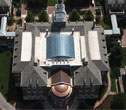NRCA has published NRCA Guidelines for Architectural Metal Flashings, which provides guidelines for contractor-fabricated architectural metal flashings used as roof assembly components. If you design, specify, fabricate or install architectural metal flashings, I encourage you to use this new manual.
The new manual
NRCA Guidelines for Architectural Metal Flashings contains excerpts from The NRCA Roofing Manual specifically applicable to architectural metal flashing systems for roof assemblies.
Chapter 1—Guidelines Applicable to Metal provides information about the various metal types, including ASTM International standard and grade designations, and metal finishes commonly used in architectural metal flashings for roof assemblies. Also, additional information is provided about the galvanic series and corrosion potential for metal that contacts other metals; oil canning; cleats, clips and fasteners; drip-edge considerations; and metal joinery methods.
Chapter 2—Guidelines Applicable to Low-slope Roof Systems provides information and illustrations applicable to architectural flashings used in low-slope roof systems. Separate sections address coping; perimeter edge metal; counterflashing and through-wall flashing; expansion joint covers; area dividers; penetrations; scuppers; gutters and downspouts; and lightning protection systems.
Chapter 3—Guidelines Applicable to Steep-slope Roof Systems provides illustrations of drip edge metal and information about gutters and downspouts; ridge and hip caps; valleys; apron and headwall flashing; backer and cricket flashing; sidewall flashing; counterflashing; and lightning protection systems. Because NRCA's guidelines for valleys and sidewall flashings differ based on steep-slope roof covering type, separate guidelines are provided for asphalt shingle, clay and concrete tile, metal and synthetic components, slate, and wood shake and shingle roof systems.
Chapter 4—Construction Details features illustrations of 48 common architectural metal flashings. Additional illustrations depict alternative configurations for some flashings commonly fabricated in multiple profiles. For example, 13 common profiles are provided illustrating exterior hanging gutters.
The appendixes address expansion coefficients for metals, referenced organizations, and U.S. and metric unit conversions.
Using the manual
The manual is intended to assist those who design, specify, fabricate or install architectural metal flashings achieve properly designed, specified, fabricated and installed long-term performing, watertight roof assemblies.
For example, designers or specifiers can select a metal type best-suited for the architectural metal flashings for a roofing project or a specific construction detail by consulting Chapter 1.
Similarly, designers and fabricators can determine the architectural metal flashing profiles for specific project conditions using Chapters 2 or 3 depending on the specific roof system type.
Also, designers and installers can determine the assembly and installation configurations for specific architectural metal flashings, including cleat and clip usage; attachment and joinery methods; and inside and outside corner detailing methods using Chapter 4.
NRCA recognizes many roofing professionals have historically used the Sheet Metal and Air Conditioning Contractors' National Association's Architectural Sheet Metal Manual as a design reference for architectural metal flashings. I encourage them to continue to do so.
However, NRCA Guidelines for Architectural Metal Flashings offers some distinct advantages by providing more detailed information about metal types and metal finishes, galvanic series and corrosion potential for metals in contact; alternative configurations for some flashings that are commonly fabricated in multiple profiles; and different guidelines for valleys and sidewall flashings for specific steep-slope roof covering types.
Getting it
NRCA Guidelines for Architectural Metal Flashings is available by calling NRCA's Customer Service Department at (866) ASK-NRCA (275-6722) or accessing shop.nrca.net.
Mark S. Graham is NRCA's associate executive director of technical services.



